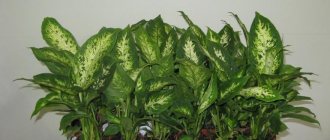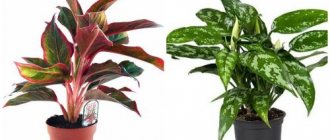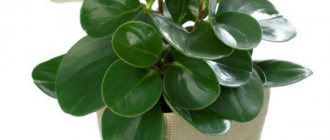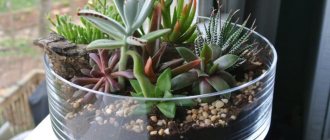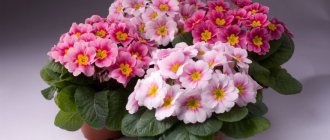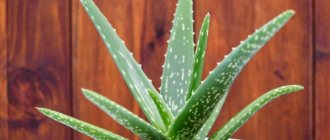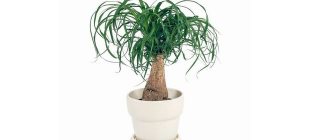In fact, the correct name for the flower is “guzmania”. But in everyday life the pronunciation with the letter “Z” has taken root. Beginning flower growers are simply sure that guzmania belongs to the category of finicky plants. Therefore, in our climate the tropical beauty is extremely uncomfortable. As practice has shown, this is a serious misconception. Guzmania does not pose any particular difficulties and tolerates climate changes favorably. But for her comfortable living, flower growers recommend creating certain conditions.
General information
The houseplant guzmania, or guzmania, is a herbaceous epiphyte belonging to the Bromeliad family. This family is quite extensive and includes about 200 species, distributed in Brazil, India and Central America.
The leaves are long (up to 45 cm), pointed, monochromatic. The guzmania flower forms a dense funnel-shaped rosette with a recess for collecting water. In this case, the roots practically do not participate in the nutrition and supply of moisture to the plant. On window sills the plant reaches a maximum of 50 cm in height.
The flowers of this epiphyte are small, inconspicuous, white or yellowish. This exotic beauty attracts attention with its bright bracts, which, depending on the variety, can be brown, burgundy, orange, or scarlet. The bracts are shorter than the rest of the leaves, making them appear like a red flower in the middle of a neat green rosette.
Watering a plant grown on a support
If guzmania is grown on a support - a bromeliad tree, it is watered in a different way.
Periodically - once every 10 days - the plant is removed from its support and immersed in a basin of water, which should be the same as during normal watering, that is, settled and warm. The plant is kept in water until completely saturated. Then the excess water is allowed to drain and the guzmania is returned to its support.
Main types and varieties of Guzmania
Of the numerous representatives of Bromeliads, the following varieties have taken root in indoor floriculture:
- Guzmania reed. In nature, it is a stemless plant with weak roots and short red bracts. Based on this species, such popular groups of Guzmania varieties as Minor (Minor Rondo), Mix and Tempo were bred. These are low plants with bracts of different colors - yellow, pink, golden-green.
- Guzmania is blood red. Its lanceolate, downward-bending leaves form a dense, goblet-shaped rosette. The plant is compact, about 20 cm in height. Flowers without peduncles are located directly in the leaf rosette. The bracts are red or yellow. During flowering, all the leaves of the rosette become colored, and the color is uneven.
- Guzmania mosaic. It grows up to 50 cm. Its long, up to 80 cm, leaves are decorated with transverse light stripes. Peduncles are low, erect; The flowers are white, small, protected by yellow sepals. The inflorescences are large and dense, attractive. The bracts are bright pink.
- Guzmania Donnell-Smith. A compact plant with beautiful dark green leaves and a graceful rosette. The inflorescence is a panicle. This guzmania began to be grown as an indoor flower relatively recently.
Breeders are actively working to develop new hybrids and varieties and improve their qualities. For example, Guzmania Ostara, obtained by crossing different natural species, is capable of “holding” flower stalks for up to six months without losing its decorative effect.
How to care for Guzmania
When caring for Guzmania at home, it is important to recreate its natural living conditions as accurately as possible. Then the plant will form a dense, beautiful rosette and bloom in a timely manner.
Lighting, temperature and humidity
Guzmania requires light, so the correct location of the pot is important for successful cultivation. The plant needs bright, but diffused light, without direct sunlight. Windows of western and eastern orientation will be optimal for it.
It is important to remember that Guzmania is native to the tropics, which means it prefers high humidity and temperature. The optimal range for the summer period is 20-25 degrees. In winter, the indoor air should not be colder than 16 degrees. In summer, Guzmania needs daily spraying; you can place it on a tray with wet expanded clay or sphagnum.
How to water Guzmania and when to fertilize
To water Guzmania, use settled water heated to room temperature. Unlike most plants, they water not the soil, but the rosette, filling the funnel-shaped depression at its top 2/3 with water. In the summer, water is left, renewing its supply daily. In winter, with a decrease in the amount of light and a drop in temperature, excess water is drained after 30 minutes; The plant is “watered” 2 times a week. The soil can be slightly moistened only during the summer heat to further increase the air humidity around the outlet.
Guzmania, as a rule, does not need additional feeding. In spring and summer, you can apply fertilizer with a high potassium content once a month, which speeds up the appearance of flower stalks. Feeding along with water is poured into the outlet.
Care after purchase, during and after flowering
Guzmania blooms at 3-5 years of life of the rosette. This impressive stage of its development, when the stipules turn bright colors, lasts about 4 months and occurs in spring or summer. Usually the plant is sold in flowering condition. After purchasing, it is advisable to transfer it to a more suitable substrate. It is advisable to carry out preventive treatments with insecticides and acaricides.
The drying of the bracts indicates that flowering has ended. After the guzmania has bloomed, it is moved to a darker place to stimulate the appearance of children. If you do not plan to collect the seeds, the peduncle is removed. Otherwise, the plant will spend most of its energy on the development of ovaries, die faster and are more likely to leave weak children. After flowering ends, they stop pouring water into the outlet, limiting themselves to rare (with complete drying) moistening of the substrate. Otherwise, the rosette will rot without leaving offspring.
Bloom
The flowering of guzmania is why this plant is grown at home. Interesting fact: guzmania blooms once in its life , and after flowering it dies, leaving “offspring”. But it may not bloom in the first year after planting, but much later. It all depends on the growing conditions.
During flowering, the plant needs abundant moisture in the substrate and monthly fertilizing from March to September. The duration and quality of flowering is affected by lighting - guzmania needs as much bright diffused light as possible.
Reproduction
Reproduction of Bromeliads at home is not difficult, but requires a fair amount of patience.
For breeding Guzmania, children or seeds are used. Children begin to form with the beginning of flowering. By the time the mother plant dries out, they usually have 3-4 leaves and a well-developed root system. The daughter rosettes are cut off, being careful not to “tear off” the roots, and placed in a mixture of peat, sphagnum and sand; keep warm until they take root. They bloom at 4-5 years of age. Flowering can be accelerated by leaving one “daughter” on the mother bush, cutting off its dried above-ground part. In this case, the young plant may bloom as early as next year.
If you decide to propagate guzmania by seeds, do not remove the peduncle and wait until they ripen. Seed material is sown immediately after collection in a mixture of peat and sand. Before planting, it is advisable to spill the substrate with potassium permanganate for disinfection. The seeds are laid out on the surface without sprinkling. The containers are placed in a greenhouse. It is important to prevent the top layer of soil from drying out by regularly moistening it with a spray bottle. At a stable temperature of 25 degrees and the presence of lower heating, the seedlings hatch after 3 weeks. After another month, they are placed in separate containers.
How to transplant Guzmania
Guzmania is rarely transplanted, only if there is a need to increase the volume of the pot. The procedure is carried out carefully, since the weak root system of this plant does not tolerate outside interference. They do not free it from the old soil, limiting it to transshipment. Transplantation of children, like adult plants, is carried out as they grow.
The soil for guzmania should include turf soil, peat, sphagnum moss and river sand in equal parts. You can purchase a ready-made substrate for Bromeliads or orchids. The pot should be tight and shallow. When replanting, the diameter is increased by 5 cm. The new container is filled 2/3 with drainage and fresh substrate is added.
The plant is removed from the old pot, being careful not to damage the root system. Place in a new container without deepening the root collar. Add fresh earthen mixture along the edges without compacting it.
You can grow guzmania without a pot, attaching it to bark or a piece of wood. For the base, choose old, loose wood and make a small depression in it. The plant is removed from the pot, trying not to shake the soil from the roots, the earth ball is wrapped in sphagnum, and secured with wire. The structure is placed in the recess and fixed.
We recommend reading
How to grow eustoma from seeds at home
Home care for Violet
Home care for Calathea
How to care for Asparagus at home
Guzmania flower
Author: Natalya February 17, 2022 Category: Houseplants
A couple of years ago, walking through the park named after. Ostrovsky with the children, I noticed that near the flower bed someone had placed two pots with the “remains” of flowers. I, as an ardent florist, could not leave them to die. The flowers were in terrible condition, each glass had three withered leaves, the flowers were different. At first, I couldn’t determine what kind of flowers they were, even leafing through the encyclopedia on floriculture, I couldn’t find anything. Therefore, I decided to care for them at my own discretion.
Mistakes in caring for Guzmania and main problems
Guzmania can be affected by scale insects and mealybugs. You can cope with pests using systemic insecticides, such as Fufanon, Aktara. It is important to spray the working solution on each sheet from above and below, paying attention to the joints. Treatments are carried out several times; The appropriate interval and concentration are indicated on the packaging.
Spider mites can also settle on Guzmania. When cobwebs or bite marks appear, the plant is treated with acaricides: Neoron, Fitoverm or others. Fungal diseases often affect Guzmania. The main reason for their appearance is non-compliance with agricultural technology, in particular, excess humidity or low temperature. When signs of powdery mildew, gray or other rot appear, the rosette is treated with fungicides, for example, Fundazol.
Sometimes owners of tropical beauties encounter difficulties caused by violations of agricultural practices.
| External manifestations | Causes | Remedies |
| Guzmania does not bloom | The absence of flowering indicates violations of agricultural technology: lack of light, heat or dry air. If you are growing a plant from a baby plant, it may be too young to flower. | Follow agricultural practices. You can stimulate flowering in the spring by applying fertilizers with water for irrigation. |
| Leaves wither | An alarming symptom indicating a rotting socket. This occurs as a result of excess or stagnation of moisture. | Drain all the water from the funnel and stop watering completely. If the leaf turgor is restored after a few days, it can be resumed. If not, the guzmania is removed from the substrate, the roots are examined for the presence of rot, the damaged areas are cut off and the sections are sprinkled with crushed charcoal. The trunk is also carefully inspected. The plant is planted in a fresh substrate with a minimum amount of nutritional components and placed in a greenhouse until rooting. |
| Bush develops slowly | The main reason is lack of nutrients. This happens more often if the plant remains in the forcing soil. Lack of light can also slow down growth. | Handle the guzmania after purchase and place the pot in a brightly lit place without direct sunlight. |
Protect your hands with gloves when pruning and replanting, as guzmania sap can cause irritation.
Transfer
As mentioned above, guzmania does not need transplants . This plant is replanted once in its entire life - after purchase. Replanting after purchase is necessary to select suitable soil and container for the flower. It is carried out by transferring from pot to pot. You should handle the roots as carefully as possible - they are very fragile and brittle .
Particular attention should be paid to choosing a pot . The fact is that guzmania begins to actively grow and can turn the pot over with its weight. Therefore, you need to choose a weighty container. It would be better if it were ceramics. The pot itself should be low and wide, with a diameter of 12-15 cm .
